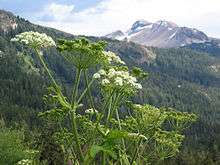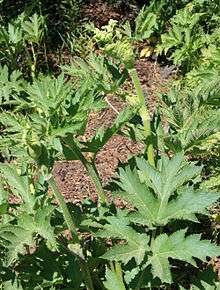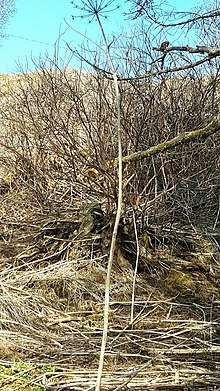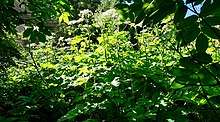Heracleum maximum
Heracleum maximum, commonly known as cow parsnip, is the only member of the genus Heracleum native to North America. It is also known as American cow-parsnip,[3] Indian celery, Indian rhubarb[4] or pushki. It is sometimes referred to as Heracleum lanatum[5] (or Heracleum lanatum var. asiaticum),[4][5] which is regarded as a synonym.[6]
| Heracleum maximum | |
|---|---|
 | |
| Cow parsnip | |
| Scientific classification | |
| Kingdom: | Plantae |
| Clade: | Tracheophytes |
| Clade: | Angiosperms |
| Clade: | Eudicots |
| Clade: | Asterids |
| Clade: | Campanulids |
| Order: | Apiales |
| Family: | Apiaceae |
| Genus: | Heracleum |
| Species: | H. maximum |
| Binomial name | |
| Heracleum maximum | |
| Synonyms[2] | |
|
See text. | |
Description

Cow parsnip is a tall herbaceous plant reaching heights of over 2 m (7 ft). The genus name Heracleum (from Heracles) refers to the very large size of all parts of these plants.[7] Cow parsnip has the characteristic flower umbels of the carrot family (Apiaceae). The umbels are about 20 centimetres (8 in) across, flat-topped or rounded, and composed of small white flowers. Sometimes the outer flowers of the umbel are much larger than the inner ones. The leaves are very large, up to 40 cm (16 in) across, and divided into lobes. The stems are stout and succulent. The seeds are 8–12 mm (0.3–0.5 in) long and 5–8 mm (0.2–0.3 in) wide.[8]
It is commonly confused with Heracleum mantegazzianum (giant hogweed),[9] which is a much larger plant that typically has purplish spots on the stems, as well as more sharply serrated leaves.[10]
Taxonomy
The Plant List (which was last updated in 2013) classified H. maximum, H. lanatum, and H. sphondylium subsp. montanum as distinct species.[11][12][13] According to both the Integrated Taxonomic Information System (ITIS) or the National Plant Germplasm System (NPGS), H. lanatum and H. maximum are synonyms for Heracleum sphondylium subsp. montanum,[14][15] a name proposed by Brummitt in 1971.[16][17]
According to The Plant List and Plants of the World Online, Heracleum lanatum and Heracleum maximum are both accepted names, the latter with no infraspecific taxa.[11][6][lower-alpha 1] On the other hand, neither are recognized as accepted names by either the ITIS or NPGS. Besides H. lanatum and H. maximum, various scientific names have been attributed to this species,[5] including:
Synonyms of the grouping previously classified Heracleum lanatum include:
- Heracleum montanum
- Heracleum sphondylium subsp. lanatum
- Heracleum sphondylium var. lanatum
- Heracleum sphondylium subsp. montanum
Several synonyms of Heracleum maximum are listed at Plants of the World Online:[6]
- Heracleum douglasii DC.
- Heracleum inperpastum Koidz.
- Heracleum lanatum Michx.
- Heracleum sphondylium var. lanatum (Michx.) Dorn
- Heracleum sphondylium subsp. lanatum (Michx.) Á.Löve & D.Löve
- Heracleum sphondylium var. tsurugisanense (Honda) H.Ohba
- Heracleum turugisanense Honda
- Pastinaca lanata Koso-Pol.
- Sphondylium lanatum (Michx.) Greene
Distribution

The species is native to North America, being distributed throughout most of the continental United States (except the Gulf Coast and a few neighboring states), ranging from the Aleutian Islands and Alaska in the far northwest to Newfoundland on the east coast, extending south as far as California, New Mexico, Kansas, Ohio, and Georgia. It occurs from sea level to elevations of about 2,700 metres (9,000 ft).[8] It is especially prevalent in Alaska, where it is often found growing amongst plants like devil's club, which is nearly identical to in size and somewhat similar in appearance, and monkshood, a very toxic flower. In Canada, it is found in every province and territory except Nunavut. It is listed as "Endangered" in Kentucky and "Special Concern" in Tennessee.[18] The plant is also found in Siberia, East Asia, and the Kuril Islands.[5][4][19][20]
Uses
The species is widely recognized as a valuable pasture plant for cows, sheep, and goats. It is also known to be important in the diets of numerous wild animals, especially bears, both grizzly bears and black bears. The thick flower stems, coming into season in early summer, can be peeled and eaten cooked when young;[21] caution should be taken as the flowers resemble those of the extremely poisonous Cicuta maculata.[22] Cow parsnip is a valuable pasture plant for cows, sheep, and goats. It is also known to be important in the diets of numerous wild animals, especially bears, both grizzly and black.[5]
Indigenous North Americans have had a variety of uses for cow parsnip, often traveling long distances in the spring—50 miles (80 km) or more—to find the succulent plant shoots.[4] The young stems and leafstalks were peeled and usually eaten raw, while early American settlers cooked the plant.[23] In terms of taste, texture, and nutrients, the peeled stalks resembled celery, which gave rise to the common name "Indian celery". The natives were aware of the toxic effects of the plant, knowing that if the outer skin were not removed, one would get an "itchy mouth" or blistering skin.[4][24] Pregnant women were warned away from the flower bud stalks to prevent newborns from asphyxiating when crying.[4]
At least seven native groups in North America used the plant as a dermatological aid.[4] It could be an ingredient in poultices applied to bruises or sores.[4][25] A poultice prepared from the roots of cow parsnip was applied to swellings, especially of the feet.[5] The dried stems were used as drinking straws for the old or infirm, or made into flutes for children. An infusion of the flowers can be rubbed on the body to repel flies and mosquitoes. A yellow dye can be made from the roots.[25]
Toxicity
The plant contains furanocoumarins such as xanthotoxin,[26] angelicin, pimpinellin and isopimpinellin, isoimperatorin, bergapten and isobergapten, 6‐isopentenyloxyisobergapten, and sphondin.[27][28][26] In one study, the young leaves did not contain xanthotoxin, but older, senescing leaves contained "substantial amounts".[26] Some of these furanocoumarins found in cow parsnip are known to have antimicrobial[27][26] properties and are responsible for a rash producing erythematous vesicles (burn-like blisters) and hyperpigmentation that occurs after getting the clear sap onto one's skin.[24][26][29] They are photosensitive, with the rash occurring only after exposure to ultraviolet light.[26][29] Because of this, phytophotodermatitis causing skin blistering may occur after coming into contact with the sap on a sunny day.[29] The scars and pigmentation from these blisters caused by some Heracleum species can last for months or years.[27]
See also
- Heracleum, the genus
- Other non-invasive Heracleum species: Heracleum sphondylium
- Tall invasive Heracleum species: Heracleum mantegazzianum, Heracleum sosnowskyi, and Heracleum persicum
- Other plants commonly mistaken for Heracleum maximum:[9] wild carrot, cow parsley, Angelica species, poison hemlock, wild parsnip
References
Footnotes
- Heracleum maximum is also accepted by the Database of Vascular Plants of Canada (VASCAN), referencing the in prep family treatment in the Flora of North America project.[2]
Citations
- "Heracleum maximum". ipni.org. International Plant Names Index. Retrieved 2018-09-20.
- "Heracleum maximum W. Bartram". data.canadensys.net. Database of Vascular Plants of Canada (VASCAN). Retrieved 16 December 2018.
- "Heracleum maximum". Go Botany. New England Wildflower Society. Retrieved 4 January 2019.
- Kuhnlein, Harriet V.; Turner, Nancy J. (1986). "Cow-Parsnip (Heracleum lanatum Michx.): An Indigenous Vegetable of Native People of Northwestern North America" (PDF). J. Ethnobiol. 6 (2): 309–324.
- Campbell, Robert B. (1991). "Ecology of Heracleum lanatum Michx. (cow parsnip) communities in northwestern Montana". Graduate Student Theses, Dissertations, & Professional Papers. The University of Montana: Graduate Student Theses, Dissertations, & Professional Papers. Retrieved September 25, 2018.
- "Heracleum maximum W.Bartram". Plants of the World Online. Royal Botanical Gardens Kew. Retrieved 4 January 2019.
- Elizabeth L. Horn (1998), Sierra Nevada Wildflowers, Mountain Press, ISBN 0-87842-388-5
- Norman F. Weeden (1996), A Sierra Nevada Flora, Wilderness Press, ISBN 0-89997-204-7
- "Heracleum maximum: Similar Species". iNaturalist.org. iNaturalist. Retrieved 2018-08-26.
- "Giant Hogweed, Heracleum mantegazzianum". maine.gov. State of Maine: Department of Agriculture, Conservation, and Forestry. Retrieved 2018-08-26.
- "Heracleum maximum W. Bartram". The Plant List, Version 1.1. 2013. Retrieved September 21, 2018.
- "Heracleum lanatum Michx". The Plant List, Version 1.1. 2013. Retrieved September 21, 2018.
- "Heracleum sphondylium subsp. montanum (Schleich. ex Gaudin) Briq". The Plant List, Version 1.1. 2013. Retrieved September 21, 2018.
- "Heracleum sphondylium ssp. montanum (Schleich. ex Gaudin) Briq". Integrated Taxonomic Information System. Retrieved September 21, 2018.
- "Taxon: Heracleum sphondylium L. subsp. montanum (Schleich. ex Gaudin) Briq". Germplasm Resources Information Network. United States Department of Agriculture, Agricultural Research Service. Retrieved September 21, 2018.
- Brummitt, R. K. (1971). "Relationship of Heracleum lanatum Michx. of North America to H. sphondylium of Europe". Rhodora. 73 (796): 578–584. JSTOR 23311734.
- Page, N. A.; Wall, R. E.; Darbyshire, S. J.; Mulligan, G. A. (2006). "The Biology of Invasive Alien Plants in Canada. 4. Heracleum mantegazzianum Sommier & Levier". Can. J. Plant Sci. 86 (2): 569–589. doi:10.4141/P05-158.
- "Heracleum maximum". Natural Resources Conservation Service PLANTS Database. USDA. Retrieved 2008-03-30.
- "Heracleum lanatum Michx". Global Biodiversity Information Facility. Retrieved September 25, 2018.
- "Heracleum lanatum: Cow Parsnip". Encyclopedia of Life. Retrieved September 25, 2018.
- Lyons, C. P. (1956). Trees, Shrubs and Flowers to Know in Washington (1st ed.). Canada: J. M. Dent & Sons. pp. 125, 196.
- Niering, William A.; Olmstead, Nancy C. (1985) [1979]. The Audubon Society Field Guide to North American Wildflowers, Eastern Region. Knopf. p. 331. ISBN 0-394-50432-1.
- Reiner, Ralph E. (1969). Introducing the Flowering Beauty of Glacier National Park and the Majestic High Rockies. Glacier Park, Inc. p. 18.
- Turner, N. J. 1973. The ethnobotany of the Bella Coola Indians of British Columbia. Syesis, 6: 193-220.
- "BRIT - Native American Ethnobotany Database". herb.umd.umich.edu.
- Camm, Edith L.; Wat, Chi-Kit; Towers, G. H. N. (15 November 1976). "An assessment of the roles of furanocoumarins in Heracleum lanatum". Canadian Journal of Botany. 54 (22): 2562–2566. doi:10.1139/b76-275.
- Bahadori, Mir Babak; Dinparast, Leila; Zengin, Gokhan (November 2016). "The Genus Heracleum: A Comprehensive Review on Its Phytochemistry, Pharmacology, and Ethnobotanical Values as a Useful Herb". Comprehensive Reviews in Food Science and Food Safety. 15 (6): 1018–1039. doi:10.1111/1541-4337.12222.
- O'Neill, Taryn; Johnson, John A.; Webster, Duncan; Gray, Christopher A. (May 2013). "The Canadian medicinal plant Heracleum maximum contains antimycobacterial diynes and furanocoumarins". Journal of Ethnopharmacology. 147 (1): 232–237. doi:10.1016/j.jep.2013.03.009.
- Meades, S.J.; Schnare, D.; Lawrence, K.; Faulkner, C. "Heracleum maximum W.Bartram". Northern Ontario Plant Database. Algoma University College and Great Lakes Forestry Centre, Sault Ste. Marie, Ontario, Canada. Retrieved 8 October 2018.
External links
| Wikimedia Commons has media related to Heracleum maximum. |
- Jepson Manual species treatment
- Heracleum maximum in the CalPhotos Photo Database, University of California, Berkeley
- Plants for a Future report on the species
